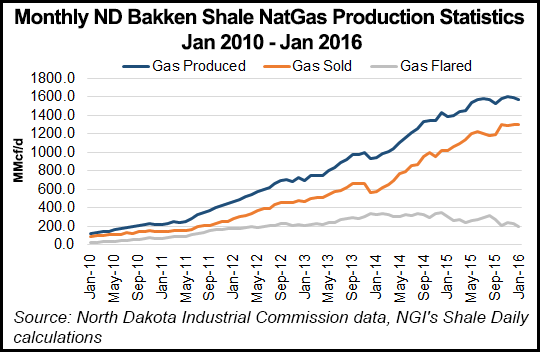Bakken Shale | E&P | NGI All News Access | NGI The Weekly Gas Market Report
Energy-Rich North Dakota Urged to Spread Its NatGas Supplies
An economic development organization and top state regulator told a North Dakota legislative committee earlier this month that the state needs to expand consumer access to Bakken Shale natural gas.

Natural gas service is an economic development tool, and too many communities in a state that is producing more than 1.6 Bcf/d don’t have access to it for lack of transmission/distribution pipeline infrastructure, said Connie Ova, president of the Economic Development Association of North Dakota (EDND) at a hearing of the state legislature’s Economic Impact Committee.
Julie Fedorchak, chair of North Dakota’s Public Service Commission, told state lawmakers that only 89 or some 457 communities currently have natural gas service. Costs to extend distribution pipeline systems can be up to $1 million/mile, and many communities have limited populations with which to share the expansion costs, said Fedorchak, who is co-vice chair of the National Association of Regulatory Utility Commissioners gas committee.
About 80% of the communities in the state lack natural gas service, equating to 40% of the state’s households and businesses, a spokesperson for Bismarck-based MDU Resources Group, parent of Montana-Dakota Utilities, told NGI.
Montana-Dakota has been asked to provide EDND with technical support as the organization works through the process with a natural gas committee it has formed among various local economic development organizations. The MDU utility is a member of EDND and many local and regional economic development organizations.
Ova told lawmakers that EDND has identified an effort by the Washington, DC-based American Gas Association (AGA), which is conducting a study of state efforts to expand gas access to underserved and unserved communities.
AGA is providing help to “facilitate the flow of information and discussion about best practices for approaching expansion plans at the state level,” an AGA spokesperson told NGI. The national association is maintaining a list of plans of 37 states that have adopted or are considering expansion proposals, he said.
In late January, Towson University’s Regional Economic Studies Institute published a report on the economic and fiscal impact of expanding gas infrastructure in Maryland, concluding that the positive impacts were substantial for residential, commercial and industrial customers based on a 10-year (2016-2026) projection. Less than half (44.2%) of Maryland’s households use natural gas as a main heating source.
Representing more than 80 economic development organizations in North Dakota, EDND has surveyed its members to identify examples of communities that have lost growth opportunities due to the lack of, or limited amount of, natural gas.
“Natural gas is a resource typically required to attract any significant manufacturing opportunity,” Ova said. “National site selectors have reported that they won’t consider a community for a manufacturing project if it does not have natural gas service.”
From the local utilities’ perspective, the MDU Resources spokesperson said, expanding service “requires running pipe a fairly good distance from a transmission pipeline, and then installing a distribution system within a town, both very expensive projects.”
© 2024 Natural Gas Intelligence. All rights reserved.
ISSN © 2577-9877 | ISSN © 1532-1266 | ISSN © 2158-8023 |
